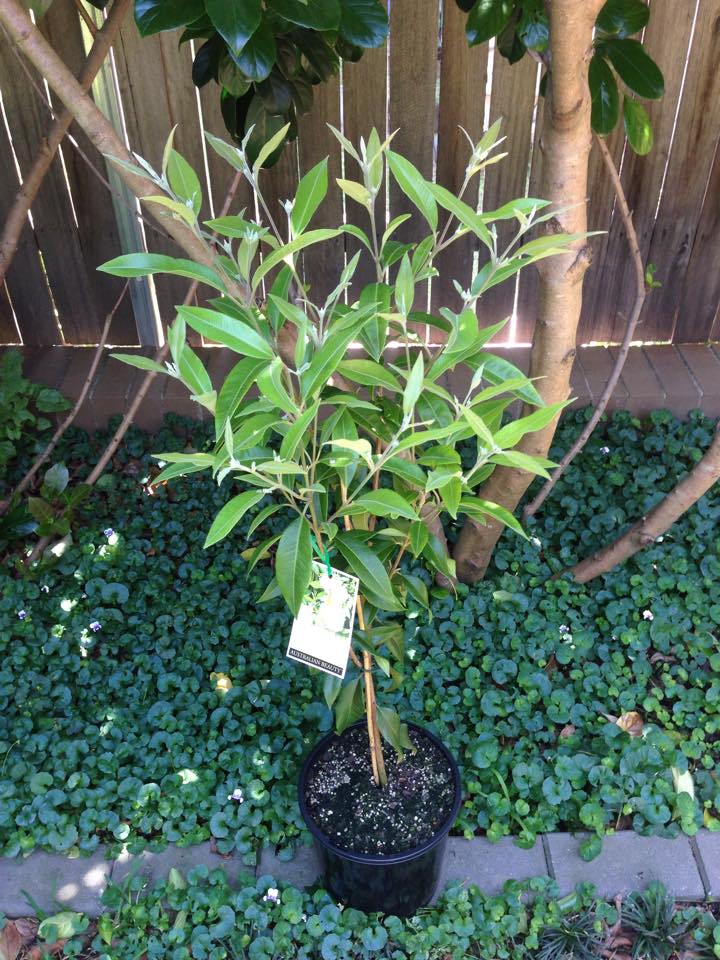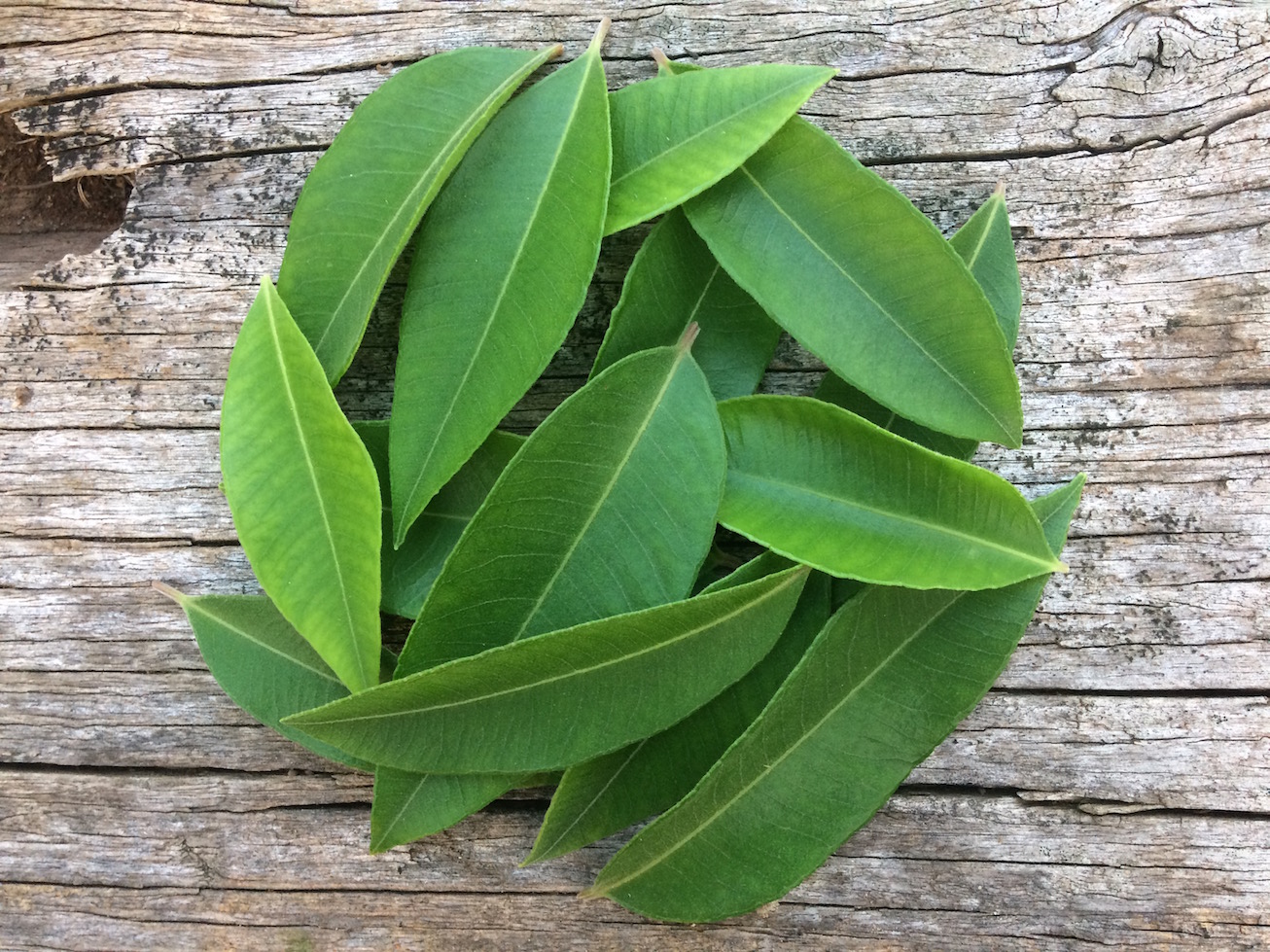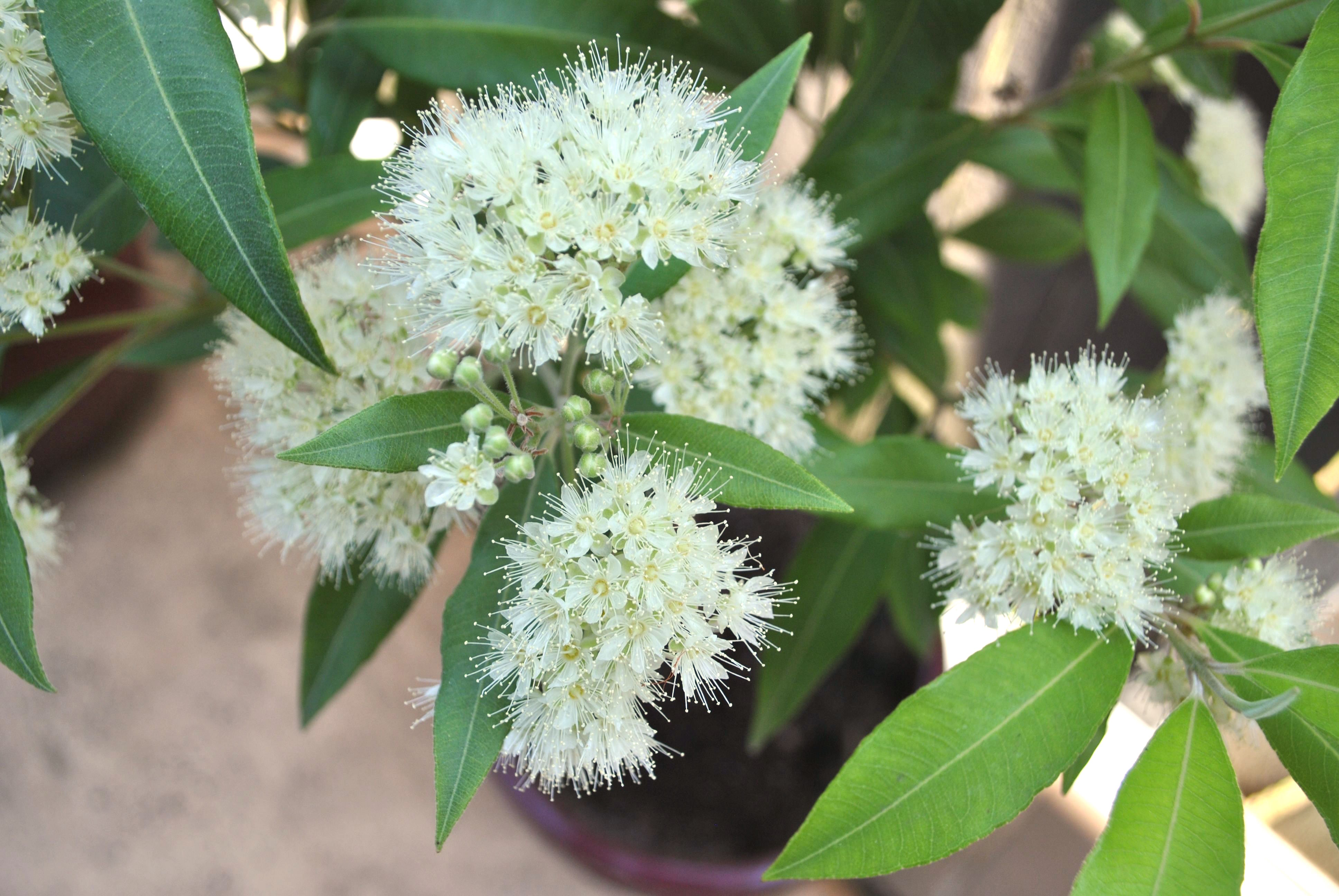Backhousia citriodora

A simple lemon myrtle tea is my favourite way of using these exquisite smelling leaves. Previously I had to pick mine from my parents’ garden, but recently I bought my own tree that I’m growing in a large pot. It’s doing well, and put on a lovely display of cream flowers for me over Christmas. So if, like me, you love lemon myrtle but don’t have much room in your backyard, try growing one in a container. They look and smell divine!
Description
Lemon myrtle is a rainforest tree, native to sub-tropical Queensland, growing 6-8 metres high, with a width of 3-5 metres. It has attractive dark green leaves, a low-branching habit and is adorned with clusters of white flowers in summer. Cinnamon myrtle and aniseed myrtle are two close relatives and all can be used in cooking.

Grow in the ground or in a container
You can grow a lemon myrtle as a medium sized tree, a tall hedge or in a large pot. It will tolerate full-sun to part shade, and requires protecting from the frost. Provide moderately fertile, well-drained soil that is slightly acidic (pH 5.5-6.5). It has relatively few issues with pests and diseases although it can suffer from myrtle rust. The seeds have a low germination rate, so it is best propagated from cuttings taken in March.
Harvesting and storage
Leaves can be harvested all year round and can be used either fresh, dried like a bay leaf, or ground. The distilled citral oil from this plant, which has a lemon-lime scent is used to make cosmetic products such as hand-creams and soaps. Fresh leaves can be stored in a container in the fridge, while dried leaves are best stored in a glass container so they don’t lose their aroma.

How can I use lemon myrtle?
With their dense foliage, they make a great screen and are also an attractive feature tree. They are a delicious food flavouring particularly for fish dishes, biscuits and desserts, and the dried leaves can be used to infuse olive oil. My favourite use is simply making a herbal infusion for tea that I drink both hot and chilled. Lemon myrtle is reported to have anti-fungal, anti-viral and calmative qualities. Two of the ways indigenous Australians used lemon myrtle is wrapping it in paperbark and using it to cook fish, and breathing in the crushed leaved to treat headaches.
Where can you buy plants?
Lemon myrtle trees can usually be sourced from your local nursery. If they are not in stock, ask if they can be ordered in, visit a native Australian nursery or order plants online.
Cinnamon myrtle Backhousia myrtifolia
Elemicin is the main essential oil in the leaves of cinnamon myrtle and this is also common to nutmeg. Use anywhere cinnamon flavour is needed as well as in curries and rice dishes, or try as a herbal infusion for tea. Trees usually grow around 7 metres high.
Aniseed Myrtle Backhousia anisata
Use the leaves in place of star anise or fennel in cooking, either fresh or dried and ground to a fine powder. The oil is thought to have anti-bacterial and anti-fungal properties. Trees grow to around 10 metres.
A lemon myrtle baked ricotta cheese-cake is high on my list of baking ideas and I’m always interested to hear how others use bushfoods so let me know if you have a favourite recipe.
Read this next:


thank you for this info I am in a region of very hot in summer and frost in winter although this winter I have seen more frost than usual and dry so containers might be for me so they can be covered in winter what do you think?
I would dearly love to buy a lemon myrtle plant but don’t know where to find it . There are plenty of lemon myrtle sites and many that are willing to sell all the by products but not a mention of where to purchase the plant . I visit the garden section of Bunnings on a regular basis but have never seen the plants on sale . Are you able to help me please .
Kind regards Rosemarie .
Hi Rosemarie, Sorry to hear this. Where do you live? You could try a native plant nursery, or there are lots of great nurseries online. Buying them as tubestock is very cost effective ($3.95). Try this link 🙂 https://www.australianplantsonline.com.au/backhousia-citriodora-lemon-scented-myrtle.html
Thanks for your informative help . I did contact the above web site and was able to purchase 2 very small tube stock plants soon after your reply . I re potted them and am anxiously waiting to see them grow . At present there is no sign of growth [impatient] and they arrived looking yellowish , not a good healthy green , I don’t know if this is normal . When visiting a Big W plant section a few days ago I saw 3 well established cinnamon mytrles , unfortunately there were no lemon scented . They were all healthy green plants so I am a bit concerned about the colour of mine . [ wouldn’t expect them to stay that way at Big W as they don’t believe in watering them , unfortunately again ] But your help was greatly appreciated and through you I have found a great supplier , pity though that they only sell tube stock . I live at Gympie QLD
Many thanks . Rosemarie Leahy
Hi Rosemarie
I have planted lots of lemon myrtle seeds and I’m waiting for them sprout, if you don’t have any luck with yours let me know, I may have had better luck with mine, I’m 30 minutes north of Gympie and I go there on a weekly basis.
Check your ph levels in the soil, I think it should be around 5.5
Regards Colleen
For lemon myrtle plants (and many other local natives) in Gympie, check out the Gympie Landcare Nursery. Or if you are south of Gympie there is the Noosa Landcare Nursery as well.
https://gympielandcare.org.au/nursery/plants-for-sale/
These types of nurseries are probably the best way to go for value.
Check Bunnings again now. I’ve been looking for a Lemon Myrtle tree for quite a while now too & found some in Bunnings (Inverell) today. Good luck! ?
I bought my Lemon Myrtle in Bunnings. I found them in 2 places, one was Australian natives the other was in
bush tucker.
Hi Rosemarie, if you are down at the Sunshine Coast from Gympie anytime, I bought a well established lemon Myrtle at Manawee Gardens Nursery in Buderim. I have seen them at Rosemount – Nambour, & Fairhill Yandina. Also probably in Noosa Nurseries. Good luck
I am in California, United States. Does anyone have lead on where to look for a lemon myrtle plant or cuttings?
Lemon Myrtle is more commonly referred to as Lemon Verbena in the States.
These guys should be able to help you:
Mountain Valley Growers Inc
38325 Pepperweed Rd, Squaw Valley, CA 93675, United States
+1 559-338-2775
Thanks for this Jenna 🙂 Plants are often called by different common names in different places. It’s helpful to be aware of this. To be sure you are getting the correct plant, it’s always best to use the botanical name which will be the same across the world. For lemon myrtle it is Backhousia citriodora.
Lemon Myrtle and Lemon Verbena are *not* the same.
The Lemon Verbena that that company sells is “Aloysia citrodora” (aka “Aloysia triphylla”)
– native to South America
– grows to 1.8m
– the oil has 30–35% citral content
Lemon Myrtle is “Backhousia citriodora”
– native to Queensland, Australia
– grows to 6m
– the oil has 90-98% citral content
You are absolutely correct David. Lemon Verbena and Lemon Myrtle are two different plants with different citral percentages, and they also have different medicinal purposes. I am growing both Lemon Verbena and Lemon Myrtle. I use both for medicinal/herbal tea purposes.
How fast do they grow if I buy a small plant?
Hi! Thanks a lot! Really enjoyed reading this page.
Like!! Thank you for publishing this awesome article.
Great page. I have a huge lemon scented in the back yard plus an aniseed myrtle that’s even bigger. They’re both in flower right now so I’ll be looking for seeds to plant. I have no idea what they look like, (the seeds) or how to propagate them but it can’t be too hard. Thanks for the great read.
Hi
I understand if you want more of a shrub prune up top and more of a tree prune below.
But in all my searches I haven’t found an answer to do you prune away the flower stems once they have bloomed and start to fall away?
Hi Nicole, you can prune them away if you don’t like the look of them but they will fall away naturally. It’s up to you. Hope this helps 🙂
Very good blog you have here but I was curious about if you
knew of any forums that cover the same topics talked about here?
I’d really love to be a part of community
where I can get advice from other experienced people that share the same interest.
If you have any recommendations, please let me know.
Bless you!
Hi Gary, What interests you the most? Gardening, sustainability or both? Do you use Facebook or any other social media platforms? It is great to be in touch with like-minded people isn’t it. I really enjoy the Crop Swap groups on Facebook because I find people are very friendly and generous with sharing information. As a general sustainability community, I enjoy 1 Million Women, who I have done some writing for. Don’t be put off by the name, everyone is very welcome to join and participate in discussion there. I’ve started a Facebook page for Small Green Things too but it can be difficult to get my posts to show up on member’s feeds.
Hi – do you have to do anything special to make lemon myrtle tea/ I have a plant and am good to go. Do they need dehydrating? Are they best crumbled, or left whole, or processed into a powder. I imagine that a powder could be used in cooking instead of lemons. Thanks in advance for any information you can provide.
Hi, I like to keep things simple when making Lemon Myrtle tea. I just pick a few leaves, scrunch them up in my hands and steep them in boiling water for around 4-5 minutes. They are great dry too, but it is not necessary to dry them unless you want to store them or mix them with other ingredients in storage. And yes, the leaves and powdered form can be used in cooking too. Some people use it (sparingly) in place of lemon grass and the flavour works well with fish but can also be used in sweet dishes (biscuits, cheese-cake). Enjoy experimenting 🙂